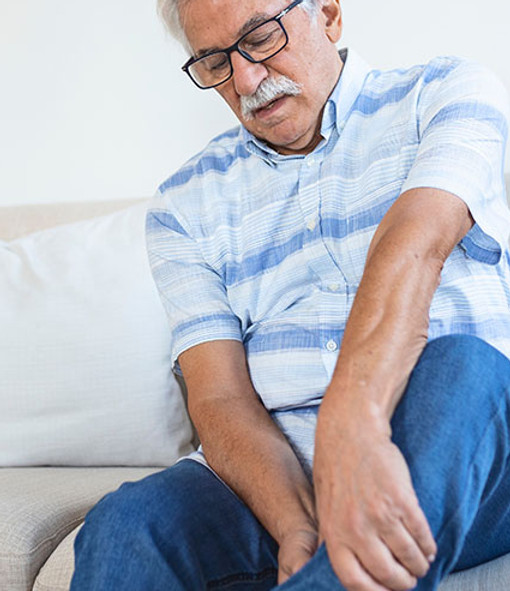
Treating knee pain with Osteopathy
MOVEMENT MECHANICS OSTEOPATHY AUCKLAND
Expert knee care in Auckland using Osteopathic treatment to relieve pain and restore mobility
Our experienced osteopaths provide expert care for knee injuries, focusing on restoring optimal function and relieving pain. We utilise manual techniques, tailored rehabilitation exercises, and postural correction to address the underlying causes of knee injuries.
Suffering from knee pain?
Knee pain can arise from various causes, including injuries such as ligament tears, meniscus damage, and patellar tendonitis, as well as degenerative conditions like osteoarthritis. Overuse and mechanical issues like IT band syndrome and muscle imbalances can also contribute to knee pain. Our experienced osteopaths specialise in diagnosing and treating different types of knee pain taking a holistic approach tailored to each patient. Osteopathy aims to address the underlying causes of knee pain, helping patients restore mobility and regain an active lifestyle.


What causes knee pain?
Accurately identifying the cause of knee pain is crucial for effective treatment and lasting relief. By pinpointing the underlying issue, whether it's ligament injuries, meniscus tears, patellofemoral pain syndrome, osteoarthritis, or tendonitis and bursitis, the appropriate course of action can be taken. Our Osteopaths offer targeted treatments tailored to each patient and their unique presentation. This ensures that the root cause is addressed, leading to improved mobility, reduced pain, and a higher likelihood of successful recovery.
How Osteopathy can help knee injuries and knee pain
Our osteopathic approach to knee injuries emphasises a patient-centred and individualised treatment plan, considering each patient's unique needs and circumstances. By addressing the root causes and employing various techniques, our osteopaths aim to alleviate pain, improve function, and support long-term recovery. The main components involve joint mobilisation (improving joint function), exercise prescription (strengthening supporting structures), pain relief, reducing inflammation, enhancing healing (promoting blood flow), load management and preventing injury recurrence.

Treating knee ligament injuries
One of the commonly injured structures in the knee are the ligaments. So what is a ligament? A ligament is a strong band of connective tissue that connects bones to other bones in the body. It plays a crucial role in providing stability and support to joints by preventing excessive movement or dislocation, maintaining proper alignment and enabling controlled movements within joints. Their function is essential in maintaining joint integrity and preventing injuries during physical activities or movements. When injured, Osteopaths can help ensure the muscles are able to provide stabilisation of the joint while the ligaments recover, improve blood flow to the impacted ligaments and encourage good-quality healing.


Knee meniscus injuries and osteo
The meniscus is a commonly injured structure in the knee. There are two meniscus in each knee made of cartilage and they serve as shock absorbers, cushioning the knee joint and helping to distribute weight and forces during movement. Meniscus injuries can occur due to sudden twisting or direct impact on the knee. Tears or damage to the meniscus can lead to pain, swelling, and limited mobility. Osteopathic treatments can effectively manage meniscus injuries by reducing inflammation, improving joint mobility, and providing rehabilitation exercises to strengthen the surrounding structures. Once the meniscus has healed, we work with patients to start appropriate loading through the knee and restoring full function.

Knee Osteoarthritis treatment Osteopathy and Shockwave Therapy
Knee osteoarthritis is a degenerative condition that affects the knee joint. It is characterised by the gradual breakdown of the protective cartilage that cushions the joint, leading to pain, stiffness, and limited mobility. Age-related wear and tear, repetitive stress on the knee joint, previous injuries, or genetic factors commonly cause osteoarthritis. Although we are unable to cure osteoarthritis, our osteopaths are able to help reduce pain associated with the condition, improve the function of the joint and help slow down further degeneration. Osteopathy and Shockwave Therapy are great non-invasive option, particularly in those too young for or wanting to hold off on surgical intervention.
Patellofemoral pain syndrome
Patellofemoral Pain Syndrome (PFPS) is a common knee condition causing pain around or behind the patella (kneecap). It typically occurs due to imbalances or misalignment between the patella and the groove in the thigh bone (femur) through which it moves. PFPS often arises from overuse, muscle imbalances, poor biomechanics, or trauma. Symptoms include knee pain, especially during climbing stairs, squatting, or prolonged sitting. Osteopathy can help correct imbalances in muscles and poor movement patterns to improve how the kneecap moves in its groove. Our osteopathic team will also address any sore muscles in the hips, ankles and lower back that have become unsettled from a change in how you move from the knee pain.


Osgood-Schlatter disease
Osgood-Schlatter disease is a condition that primarily affects adolescents during periods of rapid growth. It is characterised by pain, swelling, and tenderness at the tibial tuberosity, where the patellar tendon attaches to the shinbone (tibia). It is caused by repetitive stress or tension on the growth plate of the tibia. Osteopathy combined with shockwave therapy can provide fast and effective relief from pain associated with Osgood-Schlatter's disease. Our Osteopaths will tailor a treatment plan based on the individual's needs and symptoms. Typically, Osteopathic treatment aims to provide pain relief, reduce inflammation, promote healing, and restore normal function. It is essential to consult with a qualified healthcare professional, such as an osteopath, to determine the most appropriate and effective treatment approach for Osgood-Schlatter's disease.
Tendinitis and bursitis
Patellar and quadricep tendinopathies are knee conditions caused by inflammation and degeneration of the patellar or quadriceps tendons, often resulting from repetitive strain, overuse, or sports-related activities. Our approach combines osteopathic treatment with shockwave therapy to address these tendon injuries. Osteopathic techniques target the underlying causes, improve biomechanics, and promote healing, while shockwave therapy enhances tissue repair and reduces pain. A personalised treatment plan from an experienced osteopath helps individuals manage these conditions effectively and supports their return to normal activity levels.

Here are some of the questions we get about Osteopathy and knee pain.
Still have questions? Email hello@movementmechanics.nz
